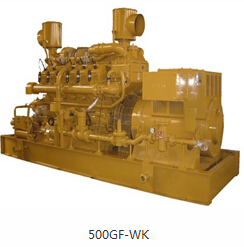Technical Introduction to Coke Oven Gas Power Generation in the Steel Coking Industry
Due to the widespread use of efficient flue gas waste heat recovery technology in coke ovens, approximately 50% to 55% of coke oven gas is surplus. Many coking enterprises in China use the remaining coke oven gas for power generation. There are three power generation modes of coke oven gas, namely steam power generation (Cogeneration), gas turbine power generation and internal combustion engine power generation. At present, these power generation modes are applied in China and have mature technologies. If the coking enterprise matches high power consumption production or collaborates with power generation and supply enterprises, and the grid electricity price is appropriate, the use of coke oven gas for power generation can be one of the preferred technological options. It is easy to operate and manage, has a long production workshop, and can adopt various methods, resulting in stable enterprise profits.
1. Steam power generation, Cogeneration for both heating and power generation
Steam power generation consists of a boiler, a condensing gas turbine, and a generator. This process uses coke oven gas as a heat source to burn the boiler, generating high-pressure steam to drive the steam turbine and generator to generate electricity. The steam power generation technology is qualified, mature and reliable. It is widely used in the coking industry in China, but its system is complex, covers a large area, and takes a long start-up time.
2. Coke oven gas used for gas turbine power generation
Gas turbine power generation is the direct combustion of coke oven gas, which drives the gas turbine to drive the generator to generate electricity. The gas turbine generator set has compact equipment, small footprint, high efficiency, good efficiency, and fast start-up speed. However, after operating for a period of time, the gas turbine must be transported back to the manufacturing plant for maintenance at a long distance, thus requiring a large amount of spare parts and requiring workers to have high technical qualifications.
3. Gas Steam Combined Cycle Power Generation Technology (CCPP)
The basic principle of this technology is to purify, mix, and pressurize the remaining coke oven gas and the recovered blast furnace gas, and then send them to the gas turbine for combustion, expansion, and power generation, driving the gas turbine generator set to generate electricity. At the same time, the high-temperature flue gas emitted by the gas turbine heats the waste heat boiler to generate steam, which drives the steam turbine generator unit and forms a combined cycle power generation. Gas steam combined power generation is the efficient cascade comprehensive utilization of thermal energy resources. Its power generation efficiency reaches more than 45%, realizing the combined production of steel and electricity. At present, many steel plants in China, such as Jigang, Baosteel, Taiyuan Iron and Steel, Shagang, Tonggang, Ansteel, Masteel, Handan Iron and Steel, Lianyuan Iron and Steel, are using this technology.
4. Using a gas internal combustion engine to drive a generator for power generation
Some coking plants in Shandong, Shanxi, Ningxia, Anwei, Hebei, Xinjiang, Inner Mongolia, Yunnan, Jiangsu, and other regions in China use gas internal combustion engines for power generation. There are 400 kilowatts, 500 kilowatts, 1200 kilowatts, and 2000 kilowatts of coke oven gas internal combustion engine generator sets available for selection. Currently, the coking industry mostly uses 500 kW coke oven gas internal combustion engine generator sets. Calculated based on the calorific value (low calorific value) of coke oven gas at 16720 kilojoules per cubic meter, 1 cubic meter of coke oven gas can generate 1.1 kilowatt hours of electricity.












 Tel:0531-69953988
Tel:0531-69953988  Add:101, Building 5, Liandong U Valley Science and Technology Innovation Center, Zhangjin Comprehensive Bonded Zone, No. 33688 Jingshi East Road, Suncun Street, Jinan Area, China (Shandong) Pilot Free Trade Zone
Add:101, Building 5, Liandong U Valley Science and Technology Innovation Center, Zhangjin Comprehensive Bonded Zone, No. 33688 Jingshi East Road, Suncun Street, Jinan Area, China (Shandong) Pilot Free Trade Zone

